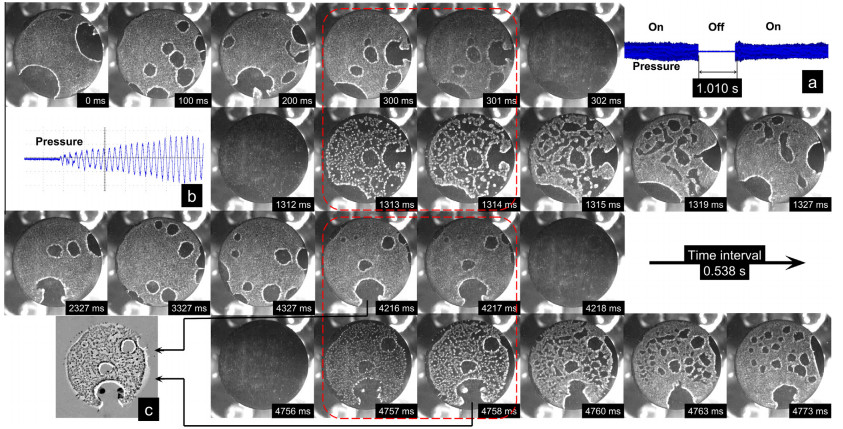After cavitation bubbles collapse, remnants of cavitation bubbles (nuclei) persist in the original location and act as seeds for subsequent cavitation events. We call this physical process "memory effect". Investigation on the memory effect will help us understand the relationship of cavitation bubble cluster and cavitation nuclei, and will contribute to the application of cavitation in ultrasonic sonochemistry, ultrasonic cleaning and ultrasonic medical treatment.
Recently, researchers BAI Lixin, LIN Weijun, WU Pengfei et al. from the Institute of Acoustics of the Chinese Academy of Sciences have investigated the temporal evolution and spatial distribution of acoustic cavitation structures experimentally by high-speed photography. They have discovered a long-term (several-second duration) memory effect in the thin liquid layer.
The memory effect of cavitation structure was achieved by repeated turn-on and turn-off of transducer, as shown in the Fig. The circular pattern of cavitation bubble cloud change greatly with time (t=0 ms, 100 ms, 200 ms, 300 ms).
After turning off the transducer for 1.01 s (Fig.1(a)), the transducer was turned on (Fig.1(b)), and the circular pattern was restored to the original shape (t=300 ms, 301 ms, 1313 ms, 1314 ms) because of memory effect.
Similar physical process was repeated again from t=2327 ms to t=4773 ms. Methods of image subtraction were adopted to remove background from the pictures before and after the time interval (Fig.1(c)). It could be seen that the two pictures were very similar (t=2416 ms and t=4758 ms).
To better evaluate the memory effect, the cross correlation coefficient between cavitation structure patterns was calculated. A factor which weakened the memory effect was also identified.

Fig. 1. Memory effect of cavitation structures in a thin liquid layer. (a) Repeated turn-on and turn-off of the transducer; (b) Acoustic pressure when turn on the transducer; (c) Comparison of cavitation structure in two pictures (Image by BAI).
The cavitation nuclei could be reordered by the motion of cavitation cluster. It was a spontaneous process caused by the interaction of cavitation bubble cluster and acoustic field. However, if the distribution of cavitation bubbles cluster could be controlled artificially, the distribution of cavitation nuclei (by the memory effect) could be controlled.
In this way, it was possible to produce cavitation bubble cluster in particular position. In turn, the uneven distribution of nuclei could lead to the formation of cavitation bubble cloud with specific structure in a short time (several milliseconds).
Funding for this research came from the National Natural Science Foundation of China (No. 11174315) (No.11474305).
Reference:
BAI Lixin, LIN Weijun, WU Pengfei, DENG Jingjun, LI Chao, XU Delong, WANG Dong, CHEN Lishuo. Memory Effect and Redistribution of Cavitation Nuclei in a Thin Liquid Layer. Ultrasonics Sonochemistry (Volume 32, September 2016, Pages 213–217). DOI:10.1016/j.ultsonch.2016.02.024
Contact:
BAI Lixin
Research Center for Ultrasonics and Technologies, Institute of Acoustics, Chinese Academy of Sciences, 100190 Beijing, China
E-mail: blx@mail.ioa.ac.cn


